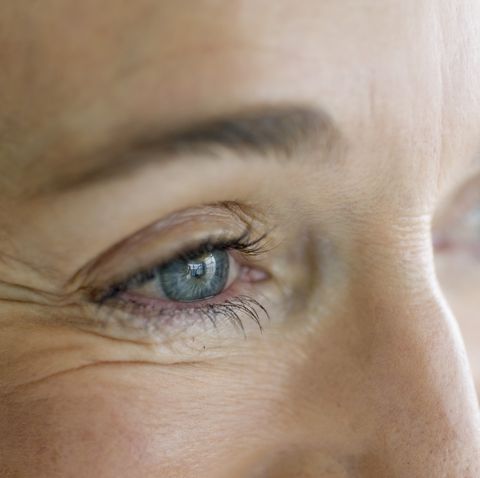They say the eyes are the window to the soul, and they’re also a telltale sign of your living habits, primarily because the skin around your eyes is some of the thinnest and most delicate on the body. Having a hard time sleeping each night? Dark circles and bags will begin to form under your eyes. Find the joy in almost everything? You’ll have those pesky little laugh lines in no time. And don’t get us wrong, laugh lines, or crow’s feet, are a sign of a life well-lived. But if you would like to minimize their appearance, New York City dermatologist Joyce Davis breaks down everything you need to know.
What are crow’s feet?
“Crow’s feet are wrinkles at the outer corner of the eyes. They resemble the feet of a crow—hence the name,” Davis explains. Before you start to freak out, crow’s feet are normal. Here’s the thing: As you age, the skin around your eye loses its elasticity and natural oils, making it more prone to wrinkles. “We develop crow’s feet due to the loss of collagen and elastic tissue within our skin. This happens naturally, with aging. Free radical formation from sun and pollution can worsen the effects. We also see these beneath the eyes as a result of excessive smiling, and muscle contraction,” she continued. “As we age, the lines get deeper and longer.”
Is there a difference between fine lines and crow’s feet?
“Fine lines are wrinkles that are not deep or wide,” Davis said. “These can occur anywhere on the face.” While crow’s feet appear due to muscle contraction, fine lines aren’t as deep and pronounced and can be treated differently than crow’s feet. “Most fine lines can be eliminated with one of the lighter skin fillers.” Davis recommends fillers like Juvederm Volbella, Resylane L, Restylane Refyne, or Belotero Balance.
What if you’re not crazy about fillers?
Topical antioxidants can also offer significant results by eradicating the free radicals that degrade collagen and elastin. “I also recommend year-round use of sunglasses that filter UV light and a side bar that protects the outer eyes. Don’t use mirrored lenses, which only attract more sunlight and bring more damage to your skin,” she advises.
How do you prevent crow’s feet?
First things first: Always wear sunscreen! “You want to start wearing SPF 30+ daily. And if you’re near or in water or very active, make sure you’re wearing a waterproof formula,” she adds. You’ll also want to start moisturizing eye creams containing proven ingredients like niacinamide, retinol and vitamin C. Ones with hyaluronic acid can also help plump skin and fill-in fine lines.
What is the best treatment for crow’s feet?
Botox:
“My go-to treatment for crow’s feet is a Botulinum Toxin (Botox), but Dysport, Jeuveau, and Xeomin all work well in this area, too,” she explained. “Botox works by blocking the release of acetylcholine, a chemical needed for muscle contraction. I typically inject the outer corners of the eyes, but some patients also get a tiny amount injected in the muscle band below each eye. By stopping contraction, the creases and wrinkles temporarily disappear.” Davis says the treatment can deliver natural results and last up to four months.
Fillers:
“Fillers can be used in the under-eye area to fill in hollows and lessen shadows. Only the lightest of fillers should be used here,” she said. “My favorite is Volbella. Fortunately, it contains lidocaine, a local anesthetic, so treatment isn’t too painful. Many of my patients come in 30 minutes earlier, anyway, to sit with a topical anesthetic cream to lessen pain further.”









